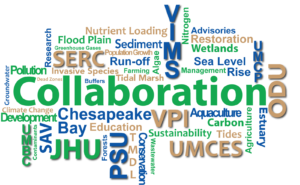 Stay up to date on the latest research around the Chesapeake with current Collaborative Research Around the Bay (CRaB) articles of our Chesapeake Quarterly newsletter. Here we highlight collaborative projects involving investigators from two or more CRC member institutions, whether recently completed, on-going, or newly initiated.
Stay up to date on the latest research around the Chesapeake with current Collaborative Research Around the Bay (CRaB) articles of our Chesapeake Quarterly newsletter. Here we highlight collaborative projects involving investigators from two or more CRC member institutions, whether recently completed, on-going, or newly initiated.
OysterFutures
Environmentalists and watermen have come together to reach a broad set of recommendations for restoring oysters in the Choptank and Little Choptank rivers. OysterFutures, led by the University of Maryland Center for Environmental Science (UMCES) and funded by National Science Foundation, is a research project aimed at achieving thriving oyster populations. Watermen and environmentalists have long debated what to do about ecosystem health in Maryland. Watermen have said that their livelihoods are at risk, and they have advocated for harvesting...
read moreBay Barcoding
A team led by the Smithsonian Environmental Research Center (SERC) and Marine Global Earth Observatory (MarineGEO), and including participants from Virginia Institute of Marine Science (VIMS), University of Maryland (UMD), Old Dominion University (ODU) George Mason University (GMU), and several other institutions conducted a large initiative to document the biodiversity of the Chesapeake Bay on July 15th to the 28th. A team of about 30 scientists took photographs, genetic barcodes, frozen tissue samples, and voucher specimens of Bay species...
read more2018 Bay Report Card
Researchers from the University of Maryland Center for Environmental Science (UMCES) gave the Chesapeake Bay an overall grade of “C” in their annual report card. Although the “C” grade has remained constant since 2012, this is the first year that scientists have seen a statistically significant positive trend. Alexandra Fries, a senior science communicator at UMCES, told The Washington Post that “the long-term trend is statistically, significantly improving over time. There are no regions in decline.” Bill Dennison,...
read moreTracking River Herring
Two types of river herring, alewife and blueback herring, used to be abundant in tributaries of the Chesapeake Bay . These days, however, herring are threatened by habitat loss, overfishing, and dams that block the route to their spawning locations. Teams from the Smithsonian Environmental Research Center (SERC) and the Horn Point Laboratory at the University of Maryland Center for Environmental Science (UMCES) are working together to better define where the river herring are now, and whether the two species of herring might prefer different...
read moreWelcoming Back Underwater Grasses
A landmark paper authored by a power-house of Bay scientists has rocked the Chesapeake Bay for the past two months. The paper looks at the long-term effects of nutrient reductions in the Chesapeake Bay watershed on underwater grasses, or submerged aquatic vegetation (SAV). It was published in the prestigious Proceedings of the National Academy of Sciences (PNAS) and written by Jonathan Lefcheck, Robert “JJ” Orth, William Dennison, and a slew of other SAV experts, including researchers from the Bigelow Lab for Ocean Science, the...
read moreOcean Deoxygenation
CRAB: Collaborative Research around the Bay In the past 50 years, the amount of water in the open ocean without oxygen has increased more than fourfold. In coastal water bodies, including estuaries and seas, low-oxygen sites have increased more than 10-fold since 1950. Scientists expect oxygen to continue dropping even outside these zones as Earth warms. To halt the decline, the world needs to rein in both climate change and nutrient pollution, an international team of scientists asserted in a new paper published Jan. 4 in Science. “Oxygen is...
read moreBay Acidification
Researchers at the University of Maryland Center for Environmental Science (UMCES), the University of Delaware, and Smithsonian Environmental Research Center (SERC) are investigating how ocean acidification could potentially compound existing problems in the Bay. A major problem already plaguing the Bay is caused by nutrient pollution. When fertilizer run off enters the Bay, nutrients in the fertilizer like nitrogen promote the growth of algae. When large populations of algae die, bacteria break down the algae, but use oxygen in the water...
read moreVirus Impacting Molting Crabs
Eric Schott, a molecular biologist with the University of Maryland Center for Environmental Science (UMCES) is investigating a virus that is plaguing blue crab shedding operations around the Bay. Schott first discovered the virus, called CsRV1, 10 years ago and it has been found to be present in up to 80% of the crabs that die in shedding operations. The goal of his research is to determine if they can identify which crabs will succumb to the virus and if genetics play a role in susceptibility. Jeff Shields of VIMS, who is collaborating with...
read moreVoluntary Farmland Conservation
A partnership between The Nature Conservancy (TNC) and the Delaware Maryland Agribusiness Association, and funding from USDA Natural Resources Conservation Service (NRCS), has been providing tools to farmers in Delaware, Maryland, and Virginia to prevent nutrient and sediment pollution in the Bay. Farmers want to prevent pollution while also increasing efficiency and productivity on their lands, so the group is providing tools to help farmers create custom conservation plans. The project, called The Delmarva Conservation Partnership, includes...
read moreOysters on Alternative Substrate
The oyster season in the Chesapeake Bay recently ended, but this year oysters harvested in the Rappahannock River came from an unusual home. Some of the oysters they harvested were grown on gravel-sized stones that had been put in the river to provide an unconventional growing spot. Usually, baby oysters, or spat, are grown on old oyster shells, and watermen have long thought that this was the best way to grow the highest numbers of oysters. But research from the Virginia Institute of Marine Science and the University of Maryland is...
read more![[Old] Chesapeake Research Consortium](https://chesapeake.org/wp-content/uploads/2017/01/LogoForDarkBack.png)
